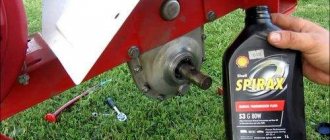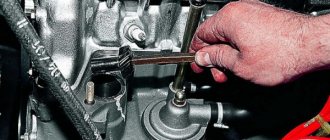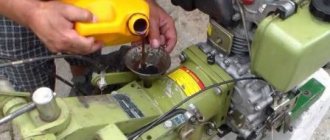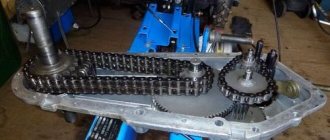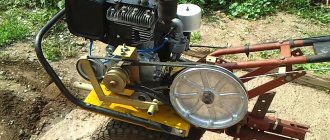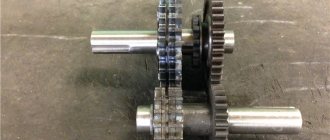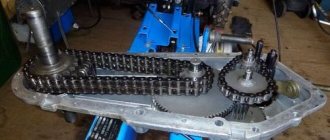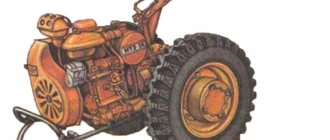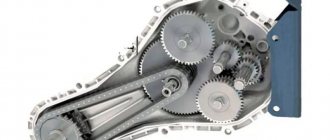Motoblock gearbox design
Like any other mechanism of a walk-behind tractor, the gearbox of an agricultural implement consists of certain elements. Taking into account the type of gearbox, its design can be equipped with certain parts. Basically, the gearbox design in detail looks like this:
- Cover and pulley;
- Bearings;
- Bushings on the input shaft;
- Adjustment and shift lever;
- Shift fork and shaft;
- Gear in the intermediate shaft;
- Shaft block;
- Double-row chain;
- Sprocket block;
- Washers and seals;
- Input shaft;
- Right and left axle shafts;
- Double star;
- Clutch;
- Bracket and spring;
- Clutch fork.
The mechanism diagram below will tell you in more detail how the walk-behind tractor gearbox works.
Despite the rather complex design of the mechanism, its dismantling and reassembly will not raise any questions even for a beginner. To do this you need:
- Completely remove the gearbox from the walk-behind tractor;
- Unscrew the screws and remove the protective covers;
- Carefully remove the bushing on the input shaft, dismantle the lever and fork that switches the mechanism;
- Remove the input shaft and gear from it;
- Remove the shaft bushings and chain;
- Dismantle the shaft block and remove the sprockets from it;
- Remove the intermediate shaft along with the gears;
- Remove the clutch, left and right axle shafts.
After completing all of the above steps, you will receive a disassembled walk-behind tractor gearbox. After repair, the mechanism must be reassembled in reverse order.
How to make a homemade walk-behind tractor with an ant gearbox
A two-stage chain gearbox is designed to reduce the rotation speed and increase the torque transmitted from the output shaft of the power unit of the walk-behind tractor to the wheels or cutters.
Chain gear drawing
1 - body made of channel No. 20); 2 - cover made of Art. sheet s5); 3 — gasket made of oil and petrol resistant technical plate) 4 — second stage drive sprocket (z = 11, t = 19.05); 5—key; 6 — bearing 206 (2 pcs.); 7— compensation sleeve; 8 - shaft; 9 — nut M22x1.5 with a spring washer; 10 - oil seal; 11 — spacer bushing with keyway; 12—eccentric bearing housing (StZ, 2 pcs.); 13 — M8 screw with spring washer (30 pcs.);
14 — driven sprocket of the second stage (z = 25, t = 19.05); 15— bearing 3008 (2 pcs.); 16 — bearing housing; 17 — sealing sleeve; 18 — left axle shaft; 19—oil drain plug (M10 screw); 20 - bottom of the body from Art. sheet s4); 21 — oil filler plug (screw Ml0); 22,23 — oil seals (2 pieces each); 24 — right axle shaft; 25 — M6 fixing screws (8 pcs.); 26 — M8 bolt; 27 - chain t = 19.05; 28 — driven sprocket of the first stage (z = 57, t = 12.7); 29 — spacer sleeve
The first stage of the gearbox includes two sprockets with 17 and 57 teeth, respectively, with a pitch of 12.75 mm. The drive sprocket with 17 teeth sits on the output shaft of the power unit, the driven sprocket sits on the outer flange of the second stage input shaft.
The second stage of the gearbox is reinforced and has a drive sprocket of 11 teeth and a driven sprocket of 25 teeth, a tooth pitch of 19.05 mm. Since during the operation of the walk-behind tractor, the second stage is located close to the cultivated soil, it is protected from dust by a closed crankcase, which is directly connected by welding to the cross members, and the crankcase side members are connected by welding through steel spacers.
A strut is welded between the crankcase and the cross member for reliability. The crankcase is welded from two channels No. 2 with shelves that are reduced in length to 35 mm. In the lower parts, the walls of the channels have the shape of a semicircle; instead of cut shelves, a bottom is welded from a 4 mm steel sheet, which is curved along the walls of the channels in the shape of a semi-cylinder. The top of the crankcase is closed with a cover with a gasket made of oil- and petrol-resistant technical plate.
Two coaxial holes d = 100 mm are made in both walls for bearing housings. Around each of them there are six other threaded holes with M8 threads, the purpose of which is to fasten the housings to the crankcase. The lower axle shaft bearings have normal housings, while the upper shaft bearings have eccentric housings. By rotating them around their axis by at least 15°, the tension of the chain of the second stage of the gearbox is adjusted in steps.
The shaft of the second stage of the gearbox is mounted in two ball bearings 206. By means of two spacers, the drive sprocket is fixed exactly in the middle between the inner walls of the crankcase and connected to the shaft by means of a feather key. On the centering boss of the right axle shaft sits a large driven sprocket, secured with six M8 bolts between the opposing flanges of the axle shafts. The lower part of the large driven sprocket and part of the chain are constantly immersed in oil.
When the walk-behind tractor engine is running, the moving chain transfers oil to the upper part of the crankcase - thus lubrication of the rubbing parts of the second stage is organized. To prevent oil leakage, oil seals are provided in the bearing housings. A rigid flange connection of the axle shafts forms a single shaft mounted in two 308 ball bearings.
What types of walk-behind tractor gearboxes are there – types and purpose
Modern walk-behind tractors are equipped with gearboxes that differ in design and purpose. The mechanisms used to operate agricultural machines are divided into the following types:
- Angular gearbox for a walk-behind tractor - a mechanism of this type serves as a connector between the motor and the transmission of the unit. The excellent characteristics and low cost of this unit make it one of the most popular among farmers. The design of the angular gear allows it to be modified, thereby increasing it, thereby significantly increasing the performance of the mechanism;
- Reducing gearbox for a walk-behind tractor - the task of this type of mechanism is to increase the power of the motor and reduce the number of its revolutions. Such gearboxes are considered one of the most reliable and efficient mechanisms, since they consist of durable steel parts that are practically resistant to wear and tear, and a standard air cooling system. Motoblocks equipped with such gearboxes can easily cope with any load and can solve many household problems;
- Reverse gearbox - this reverse rotation mechanism is installed between bevel gears, which, in turn, are located on the main shaft of the walk-behind tractor. This reversible circuit is quite simple, so disassembling it takes no more than 10 minutes. The main advantage of a reversible gearbox is the ability to reverse. The disadvantages include the low performance of the mechanism and the low speed when moving the walk-behind tractor in reverse;
- Gear reducer for walk-behind tractor - this type of mechanism is equipped with heavy walk-behind tractors. It is used primarily to transmit the torque generated by the motor to the wheels of an agricultural machine. Among the main advantages of a gear reducer, high reliability and simplicity of design should be highlighted. The only disadvantage of such a mechanism is the difficulty of maintenance. However, most walk-behind tractor manufacturers equip their equipment with a gear reducer. If you are planning to make a homemade gearbox, then it is best to make a gear-type mechanism;
- Worm gearbox on a walk-behind tractor - the distinctive features of this mechanism include the presence of a special screw and a toothed worm wheel. For the manufacture of each of the elements of such a gearbox, materials with increased strength are used. The gear ratios of worm gearboxes range from 1 to 4. The number of gears directly depends on the number of threaded channels on the mechanism screw. Among the main advantages of a worm gearbox, the high efficiency of the mechanism should be highlighted. It is used in the production of equipment that requires reduced angular velocity and the highest possible torque. The worm gearbox ensures smooth running and low noise levels when operating the walk-behind tractor.
Each of the listed types of mechanisms has its own advantages and disadvantages. This should be remembered when choosing a walk-behind tractor equipped with one or another gearbox.
Specifications
The table below shows the complete specifications of the motorized device:
| Engine's type: | 4 stroke |
| Cooling system: | Air |
| Number of forward gears: | 1 |
| Number of reverse gears: | 1 |
| Cultivation width: | 900 mm |
| Cultivation depth: | 145 mm |
| Engine model: | 168FA-2 |
| Fuel type: | Petrol |
| Launch type: | Manual |
| Fuel tank volume: | 3.6 l |
| Fuel consumption: | 1.6 l/hour |
| Engine displacement: | 196 cc |
| Engine power: | 6.5 hp |
| Size: | 1430x520x820 mm |
| Weight: | 104 kg |
| Guarantee: | 12 months |
| Manufacturer country: | China |
Do-it-yourself gearbox for a walk-behind tractor
Many walk-behind tractor owners often wonder how to make a gearbox with their own hands. This is not as difficult to do as it might seem. To work, you need to prepare a number of tools. You will need:
- Straight and oblique screwdriver;
- Hacksaw for cutting metal;
- Pliers or pliers;
- Vise.
The procedure for manufacturing a gearbox for a walk-behind tractor is as follows:
- First of all, you need to make the mechanism body. To do this, take several steel plates and weld them together in the form of a box. To save time, you can also take the housing from the shaft of the Ural motorcycle and modify it a little;
- To make the gearbox you will also need gears. They can be taken from the old Druzhba chainsaw. The main thing is that each gear has intact teeth, otherwise the homemade mechanism will not work;
- Cut off the tip in one of the shafts and drill a hole;
- On the other side of the gearbox, install the second shaft and attach the race and bearings to it;
- Finally, the output shaft will need to be connected to a pulley.
A home-made gearbox for a walk-behind tractor has a simple design, so repairs to the mechanism can be completed in 20–30 minutes.
What kind of oil should I pour into the walk-behind tractor gearbox?
Not only beginners, but also experienced farmers should know the answer to this question.
The serviceability and service life of the walk-behind tractor gearbox largely depend on the quality and characteristics of the oil. Before purchasing a lubricant, you should read the recommendations of the agricultural machine manufacturer. The second important factor is the cost of oil. There is no need to buy the cheapest lubricants, since in most cases they are not capable of ensuring normal operation of the mechanism.
Oils for walk-behind tractor gearboxes are divided into several types. Depending on the labeling, the following lubricants are found on the market:
- SAE - these compounds are used in conditions with frequent and severe temperature changes. Thanks to this, oils with this label can be used almost all year round. When purchasing such oil, you need to pay attention to the number that is located in front of the letter W. The lower the number, the lower the temperature at which the oil can be filled;
- ASEA - oils with this marking are considered almost universal. Moreover, the higher the number in the labeling, the more difficult the conditions in which the composition is used;
- API - oils with this marking are the most common. They are successfully used to lubricate all types of gearboxes, and ensure long-term operation of mechanisms under the most severe conditions.
All of the listed types of motor block gearbox oils have their own characteristics. Be sure to study them and compare the indicators with the recommendations specified in the walk-behind tractor operating manual.
Description
The petrol walk-behind tractor Bison PS-Q70 (6.5 hp) is a representative of heavy agricultural machinery that is used for cultivating all types of soil in small areas (up to 70 acres). The petrol model Bison PS-Q70 is an ideal solution for summer residents, village residents and greenhouse owners.
Motoblock Zubr petrol PS-Q70
The compact dimensions and light weight (82 kg) of the walk-behind tractor allow it to be transported in the trunk of a car to its destination. A large assortment of attachments turns the soil cultivating unit into a multifunctional device capable of handling all agricultural work, including:
- plowing the land;
- cutting furrows for planting plants;
- planting potatoes;
- hilling of plants;
- weeding on the site;
- harvesting;
- watering;
- transportation of goods up to 350 kg;
- snow removal in winter;
- procurement of dry feed for livestock, etc.
Attachments and trailed equipment will help you perform the above work:
- hitch;
- rototillers (active and “crow’s feet”);
- reversible plow;
- hillers;
- disks;
- weed weeds;
- flat cutters;
- mower;
- water pump;
- snow blower;
- equipment for planting and digging potatoes;
- trailed trolley with a carrying capacity of up to 350 kg (bulk and piece cargo).
Check out the video review of the Zubr PS-Q70 walk-behind tractor:
Changing the oil in a walk-behind tractor - a detailed algorithm for beginners
Before pouring a new lubricant into the gearbox, it is necessary to clean the mechanism of the used composition. The oil change looks like this:
- Place the walk-behind tractor on a level, raised surface. It is best if there is an inspection hole in the garage - by installing the unit above it, it will be much easier for you to change the oil in the gearbox of the walk-behind tractor;
- The mechanism has 2 plugs. One of them is used to drain the used composition, and the second closes the hole in which a new product needs to be poured;
- First, unscrew the oil filler cap. After this, place a wide container under the drain plug;
- Carefully unscrew the drain cap and wait until the used oil flows out;
- After this, screw the drain cap until it stops using a spanner;
- Insert a funnel into the filling hole and add new oil;
- Then screw the cap on and unscrew it again - at the end of the cap there is a 10-centimeter dipstick that will help determine the amount of oil filled. If the oil is at the end of the dipstick, it means that you no longer need to add lubricant. The video will tell you in more detail about changing the oil in the gearbox of a walk-behind tractor.
Under normal operating conditions, the oil in the walk-behind tractor gearbox should be changed no more than once every 100 hours of operation. If the unit is used around the clock, then this must be done more often - at least 1 time for every 50 hours of operation. This will help prevent breakdowns not only of the gearbox, but also of other mechanisms of the agricultural machine.
Should I buy a Forza 105 walk-behind tractor?
The agricultural equipment market today is saturated with a variety of equipment. If you read the reviews left on the forums, the Forza walk-behind tractor has the most flattering recommendations. This machine was developed and put into production at the domestic enterprise UralBenzoTech. The first Forza walk-behind tractor rolled off the assembly line back in 2010. Since then, specialists from the Perm plant have made many changes and additions to this product, bringing its performance characteristics almost to perfection. Thanks to this, the TM Forza 105 walk-behind tractor has taken a leading position in the Russian market, providing worthy competition to foreign-made analogues. The machine’s engines are distinguished by high power and reliability, which allows processing large areas with high quality, quickly and with minimal expenditure of muscular effort. Today, the products of the UralBenzoTech enterprise are known not only outside the region, but also throughout the country. Moreover, throughout Russia there is a wide network of service centers for the sale, repair and maintenance of equipment, owned by the manufacturer of the Forza walk-behind tractor.
How much oil to fill in the gearbox of a walk-behind tractor?
Finding the answer to this question is quite simple. To do this you will need to proceed in the following order:
- Place the walk-behind tractor on a flat surface so that the wings of the unit are parallel to the surface itself;
- Take a piece of wire at least 70 cm long - it will act as an oil dipstick;
- Bend the wire into an arc;
- Insert the wire inside the tank to the very end and pull it out.
If the oil is at the level of 30 cm of the wire length, then you no longer need to add oil. If the wire remains completely dry, then you will need to pour at least 2 liters of lubricant inside the gearbox.
How to change oil seals on a walk-behind tractor?
If you find an oil leak from the walk-behind tractor gearbox, this indicates the need to replace the mechanism oil seal. This procedure is performed in the following order:
- First, remove the cutters from the shaft, thoroughly clean them of dirt and oil residues;
- Unscrew the bolts of the cover protecting the gearbox. If the lid “sits” too tightly on the body, you need to tap it with a hammer;
- Pull out the old oil seal and wipe the area under it;
- Apply sealant to the edges of the new oil seal, install the part and tighten the gearbox cover.
On average, replacing an oil seal takes no more than 10 minutes.
Before operating the walk-behind tractor, be sure to ensure that the sealant is completely dry. All of the listed tips for changing oil and oil seals for walk-behind tractor gearboxes are suitable for agricultural machines Farmer, SKA, Neva MB-1 and MB-2, as well as for units of the Kaskad and Oka brands.
